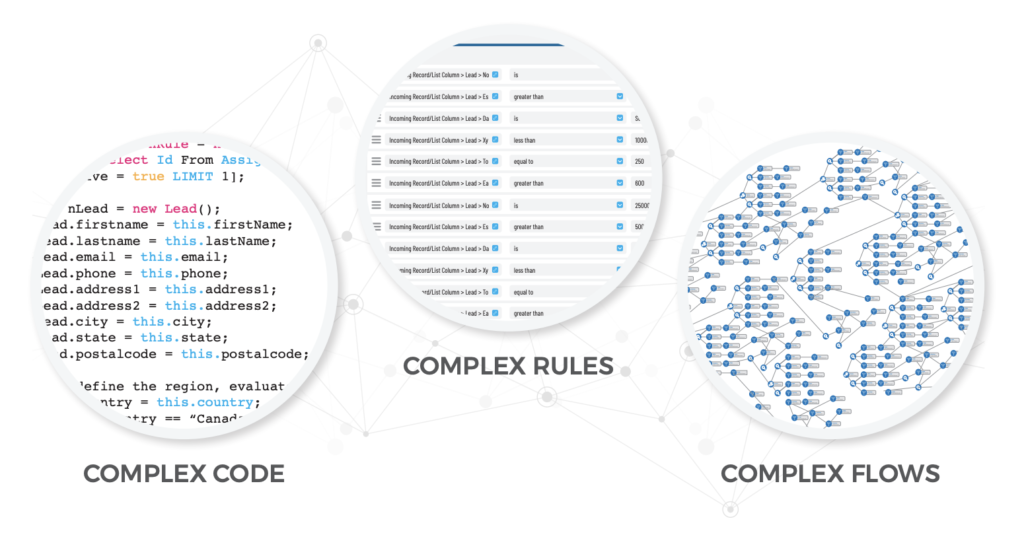Salesforce lead-to-account matching is an important consideration in better aligning Sales with Marketing and increasing the efficiency and productivity of go-to-market (GTM) teams. Additionally, it’s an absolutely essential component in any effective account-based marketing (ABM) workflow.
Lead-to-account matching is simply defined as the process that matches leads to – or filters leads from – existing accounts in your CRM. Matching leads to accounts eliminates two potentially huge blunders: it prevents your sales representatives from working leads at both existing customer accounts and active opportunities.
![]()
Not only does the prospecting of the wrong accounts take up precious time Sales could spend pursuing net-new opportunities, pitching an existing customer or active opportunity is poor form at its worst, and an absolutely horrible experience for your customer. But, without effective lead-to-account matching processes, it happens for a variety of reasons, including:
- New “leads” from existing customer accounts fill out forms for content, register for events, and sometimes even request demos
- A lead rolls up into an active opportunity being worked by a different member of the Sales team
- Leads targeted by sales channel partners get erroneously routed to Insides Sales
- Leads are duplicated in the CRM
- ABM and other outbound leads are misrouted
The post solves for the easy way to effective Salesforce lead-to-account matching.
Lead-to-Account Matching Automation
Manual lead-to-account matching is always an option, but for businesses with a meaningful volume of leads, it can be extraordinarily time-consuming, and time equals money. Not only do you have to pay personnel to manually match leads to accounts, it takes longer to get the task accomplished, negatively impacting your lead response time and, ultimately, conversion.
Fortunately, there are automated solutions like LeanData Matching that connect data and build holistic contextual account overviews to empower your team to accelerate revenue. But, be forewarned: there are a great many lead-to-account matching tools that handle the task of matching, but they fall far short in other critical data-related tasks like lead enrichment and lead routing, causing more manual work and costly delays in getting actionable leads to your Sales team.

As part of its efforts to monitor and prevent duplicate records, Salesforce delivered upon duplicate management in its Spring 2015 release. As part of that effort, SFDC debuted its lead-to-account matching functionality, a relatively new feature that saves time and money, and allows you to customize for special instances your business might encounter.
Standard Matching Rules
Your Salesforce instance comes with three standard matching rules: one for business accounts, one for contacts and leads, and another for person accounts. You can use Salesforce’s standard matching rules with duplicate rules and duplicate jobs, and while you can’t edit standard matching rules, you can create your own custom matching rules.
The standard account, person account, contact and lead matching rules all identify duplicates using match keys, a matching equation, and matching criteria. The standard account, contact and lead matching rules are all activated by default. However, for the standard person account matching rule, you must first enable person accounts and then activate the rule through the Setup menu.
Within the Setup menu, configure and match rules to the object selected to match against. Matching criteria defines how broadly a match is defined for each field, and how you want it performed. Common matching criteria includes fields like account name, email, contact email address, or a combination of these.
Then, create a duplicate rule on the object, allowing you to action the matching rule – or rules – you’ve configured. Duplicate rules span multiple objects and match against any object in Salesforce, giving SFDC-native duplicate management its power.
The Difficulties with Lead-to-Account Matching in Salesforce
The opportunities with Salesforce lead-to-account matching goes back to its roots. When SFDC set up its data infrastructure, two different objects related to people – both leads and contacts – were created. While leads will typically be converted to contacts as part of an end-to-end GTM motion, at any snapshot in time the default organizational infrastructure leaves you with twice the fields, twice the reporting and an environment ripe for confusing duplication.
The fix? Most often, it’s custom code and custom rules for your SFDC instance, resulting in increasingly complex go-to-market flows and the possibility – or even probability – of more confusion.
LeanData’s Lead-to-Account Matching SFDC Solution
When leads are disconnected from accounts, it poses a variety of challenges, ranging from embarrassing prospecting calls to existing customers to costly, time-consuming efforts to perform lead researching and triaging. LeanData Matching makes the data connections and delivers holistic contextual information to your Sales team.
LeanData’s industry-best fuzzy matching algorithm looks beyond just email domain-based matching and analyzes multiple data points to ensure the highest-fidelity account match. Your own matching rules ensure multiple account matches, complex parent-child account hierarchies and duplicate accounts are handled the way your business prefers. And, as matching results are always updated in real-time, your data remains completely native in Salesforce.
Summary
Without lead-to-account matching, your revenue team not only runs inefficiently, it also risks running ineffectively too. Automating lead-to-account matching eliminates time-consuming manual tasks and allows you to better increase your speed to lead. And, while Salesforce has its own matching functionality, more complex GTM motions benefit from specialized solutions.








